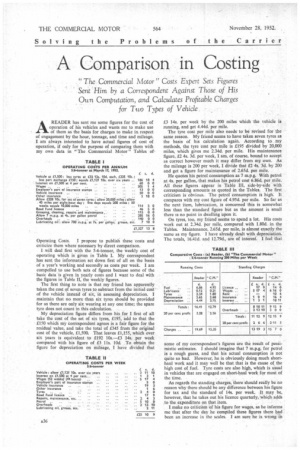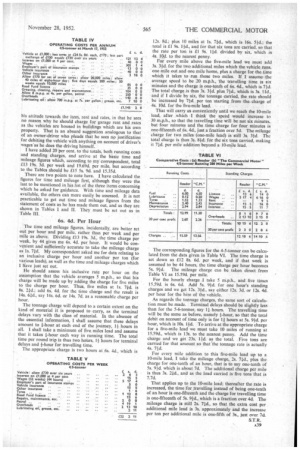A Comparison in Costing
Page 54

Page 57

If you've noticed an error in this article please click here to report it so we can fix it.
" The Commercial Motor >' Costs Expert Sets Figures Sent 'Him by a Correspondent Against Those of His Own Computation, and Calculates Profitable Charges for Two Types of Vehicle AREADER has sent me some figures for the cost of operation of his vehicles and wants me to make use of them as the basis for charges to make in respect of engagement by the hour, tonnage, and time and mileage.
I am always interested to have actual figures of cost of operation, if only for the purpose of comparing them with my own data in " The Commercial Motor" Tables of Operating Costs, I propose to publish these 'costs and criticize them where necessary by direct comparison.
1 will deal first with the 5-6-tonner, the weekly cost of operating which is given in Table I. My correspondent has sent the information set down first of all on the basis of a year's working and secondly as costs per week. I am compelled to use both sets of figures because some of the basic data is given in yearly costs and I want to deal with the figures in Table II, the weekly figures.
The first thing to note is that my friend has apparently taken the cost of seven tyres to subtract from the initial cost • of the vehicle instead of six, in assessing depreciation. I maintain that no more than six tyres should be provided for as there are only six wearing at any one time; the spare tyre does not count in this calculation.
My depreciation figure differs from his for I first of all take the cost of the set of six tyres, £195, add to that the £150 which my correspondent agrees is a fair figure for the residual value, and take the total of £345 from the original cost of the vehicle, 0,500. That leaves 11,155, which over six years is equivalent to £192 108.—£3 14s. per week compared with his figure of £3 I ls. 10d. To obtain the figure for depreciation on mileage, I have divided that £3 14s. per week by the 200 miles which the vehicle is running, and get 4.44d, per mile.
The tyre cost per mile also needs to be revised for the same reason. My friend seems to have taken seven tyres as the basis of his calculation again. According to my methods, the tyre Cost per mile is £195 divided by 20,000 miles, which gives me 2.34d. per mile. His maintenance figure, £2 4s. 3d. per week, I am, of course, bound to accept as Correct however much it may differ from my own. As the mileage is 200 per week, I divide that £2 4s. 3d. by 200 and get a figure for maintenance of 2.65d. per mile.
He quotes his petrol consumption as 7 m.p.g. With petrol at 4s. per gallon, that makes his petrol cost 6.86d. per mile. All these figures appear in Table III, side-by-side with corresponding amounts as quoted in the Tables. The first criticism is obvious. The petrol consumption is high. It compares with my cost figure of 4.95d. per mile. So far as the next item, lubrication, is concerned this is somewhat less than the standard figure but as the amount is small there is no point in dwelling upon it.
On tyres, too, my friend seems to spend a lot. His costs work out at 2.34d. per mite, compared with 1.80d. in the Tables. Maintenance, 2.65d. per mile, is almost exactly the same as my figure. I have already dealt with depreciation. The totals, 16.41d. and 12.79d., are of interest. I feel that
some of my correspondent's figures are the result of pessimistic estimates. I should imagine that 7 m.p.g. for petrol is a rough guess, and that his actual consumption is not quite so bad. However, he is obviously doing much shorthaul work and it may well be that that is the cause of the high cost of fuel. Tyre costs are also high, which is Usual in vehicles that are engaged on short-haul work for most of the time.
As regards the standing charges, there should really be no reason why there should be any difference between his figure for tax and the standard of 14s. per week. It may be, however, that he takes out his licence quarterly, which adds to the expenditure on that item.
I make no criticism of his figure for wages, as he informs me that after the day he compiled these figures there had been an increase in the scales. I am sure he is wrong
his attitude towards the item, rent and rates, in that he sees no reason why he should charge for garage rent and rates as the vehicles are housed in buildings which are his own property. That is an absurd suggestion analogous to that of an owner-driver who pleads that he sees no justification for debiting the vehicle with anything on account of driver's wages'as he does the driving himself.
I have added 20 per cent. to the totals, both running costs and standing charges, and arrive at the basic time and mileage figures which, according to my correspondent, total £13 19s. 3d. per week and 19.69d. per mile, but according to the Tables should be £15 5s. 9d. and I5.35d.
There are two points to note here. I have calculated the figures for time and mileage first, although they were the last to be mentioned in his list of the three items concerning which he asked for guidance. With time and mileage data available, the others can more easily be assessed. It is not practicable to get out time and mileage figures from the statement of costs as he has made them out, and as they arc shown in Tables I and 11. They must be set out as in Table TU.
6s. 4d. Per Hour The time and mileage figures, incidentally, are better set out per hour and per mile, rather than per week and per mile as above. Dividing f13 19s. 3d., the time charge per week, by 44 gives me 6s. 4d. per hour. It would be convenient and sufficiently accurate to take the mileage charge as Is. 71d. My correspondent asked me for data relating to an inclusive charge per hoer and another per ton (for various leads), as well as the time and mileage charges which 1 llave just set out.
He should assess his inclusive rate per hour on the assumption that the vehicle averages 5 m.p.h., so that his charge will be made up by adding the charge for five miles to the charge per hour. Thus, five miles at Is. 71d. is 8s. 21d.; add 6s. 4d. for the time charge and the result is 145. 6d., say 14s. 6d. or I4s. 7d. as a reasonable charge per hour.
The tonnage charge will depend to a certain extent on the kind of material it is proposed to carry, as the terminal delays vary with the class of material. In the absence of the essential information, I shall assume that these delays amount to 1-hour at each end of the journey, 11 hours in all. I shall take a minimum of five miles lead and assume that it takes 1-hour each way in running time. The total time per round trip is thus two hobrs, lf hours for terminal delays and f-hour for travelling time.
The appropriate charge is two hours at 6s. 4d., which is 12s. 8d.; plus 10 miles at Is. 7fd., which is I6s. 54d.; the total is 9s. lid., and for that six tons are carried, so that the rate per ton is £1 9s. lid. divided by six, which is 4s. 10c1. to the nearest penny.
For every mile above the five-mile lead we must add 3s. 31d. for the two additional miles which the vehicle runs. one mile out and one mile home, plus a charge for the time which it takes to run those two miles. If I assume the average speed to be 20 m.p.h., the travelling time is six minutes and the charge is one-tenth of 6s. 4d., which is 7.14. The total charge is thus 3s. 31d. plus 71d., which is 3s. I Id., and if I divide by six, the tonnage carried, the rate should be increased by 71d. per ton starting from the. charge of 4s. 10d. for the five-mile lead. •• That will carry us conveniently until we reach the 10-mile lead, after which I think the speed would increase to 30 m.p.h., so that the. travelling time will be not six minutes, but four minutes and the time charge for four minutes is one-fifteenth of §s. 4d., just a fraction over 5d. The mileage charge for two miles (one-mile lead) is still 3s. 31d. The total charge is thus 3s. 81d. for the six tons carried, making it 71d, per mile addition beyond a I0-mile lead.
The corresponding figures for the 4-5-tonner can be calculated from the data given in Table VI. The time charge is set down as £12 8s. 6d. per week, and if that week is assumed to be 44 hours, the time charge per hour becomes 5s. 91d. The mileage charge can be taken direct from Table VI as 15.59d. per mile.
For the hourly charge I take 5 m.p.h., and five times 15.59d. is 6s. 6d. Add 5s. 9fd. for one hour's standing charges and we get 12s. 34d., say either 12s. 3d. or I28. 4d. per hour for the hire of the vehicle.
As regards the tonnage charges, the same sort of calculation must be made. Terminal delays should be slightly less than for the 5-6-tonner, say I f hours. The travelling time will be the same as before, namely f-hour, so that the total debit on account of time only is for 11 hours at 5s. 9fd. per hour, which is 10s. lid. To arrive at the appropriate charge for a five-mile lead we must take 10 miles of running at 15.59d., which is 13s. to the nearest penny. Add the time charge and we get 23s. ltd. as the total. Five tons are carried for that amount so that the tonnage rate is actually 4s. 71d.
For every mile addition to this five-mile lead up to a 10-mile lead, I take the mileage charge, 2s. 71d., plus the charge for one-tenth of an hour, that is to say one-tenth of 5s. 91d. which is about 7d. The additional charge per mile is thus 3s. 24d., and as the load carried is five tons that is 7.7d.
That applies up to the 10-mile lead; thereafter the rate is increased, the time for travelling instead of being one-tenth of an hour is one-fifteenth and the charge for travelling time is one-fifteenth of 5s. 91d., which is a fraction over 4d. The mileage charge is still 28. 71d., so that the extra cost per additional mile lead is 3s. approximately and the increase per ton per additional mile is one-fifth of 3s., just over 7d. S.T.R. A39




















































































